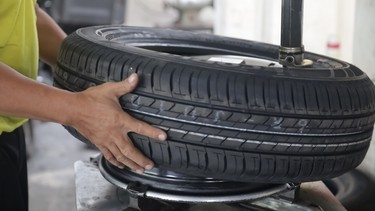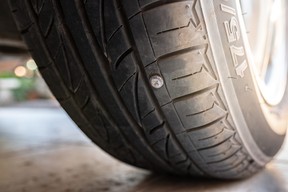Clues to watch for when sizing up a set of used tires

Article content
Tire change season is upon us, and tire shop staff across the country are in the midst of their busiest season. If you’re heading in for a seasonal tire changeover, be sure to bring your favourite technician a coffee — they need it.
Advertisement 2
Article content
Maybe you’re about to buy a used truck or SUV that comes with a second set of tires and rims; maybe you’re doing your seasonal tire swap in your driveway; or maybe you’re about to pull that trusty set of winter rubber out of storage. Whatever the case, it’s the time of year when many drivers will have their rims and tires off of their vehicles and in their hands, making it easy to give these vital parts a good, close inspection.
Article content
Whether inspecting a set of tires you’ve had on your car for ages or a new-to-you set included with that used Civic you’re considering, we’ll cover a few tire and rim inspection pointers below, which can help save money and prevent headaches.
Thankfully, a lot of potential tire- and rim-related trouble is easy to spot with your bare eyes. With the tires and rims removed from the vehicle you’re considering, its easy to inspect the inward-facing surfaces of both to help make a more thorough investigation.
Advertisement 3
Article content
When checking tires, start by carefully inspecting both the inner and outer sidewalls. Thin cracks can indicate a tire that’s old and aged, which can affect safety. Bigger cracks, splits, and gouges can indicate damage caused by a pothole or some road hazard, which can be a safety concern. If you notice any, assume the tire needs to be replaced until you have a professional opinion to the contrary.
A damaged tire may be weakened, and turn into a time-bomb waiting for a blowout on the next available pothole.
Old tires can be a ticking time bomb, too. That’s why it’s important to look for the DOT date code on the tires, which reveals their birthday. On the sidewall of each tire, you should see the letters ‘DOT’ followed by a number. The final four digits of the number indicate the week (first 2 digits) and year (second 2 digits) the tire was made. For instance, a DOT code ending in 2820 would indicate a tire made on the 28th week of 2020. Week and year stamps may also be found set in a small oval.
Advertisement 4
Article content
-
![Your Questions Answered: Tires and tire care]()
Your Questions Answered: Tires and tire care
-
![Troubleshooter: Mismatched tires — it's not just the size that matters]()
Troubleshooter: Mismatched tires — it’s not just the size that matters
Tread depth can be visually assessed by looking at tire wear bars. Look for ‘TWI’ markings at the edge of the tread, then glance across the tread from there to find a raised block in a main groove. Tire tread is at the end of its life when the surrounding tread blocks have worn flush with these wear bars.
Generally, tires have a lifespan of 6 to 10 years regardless of tread depth. Check product literature for the specifics. Remember that just like eating expired meat, running old tires can be dangerous.
While you’re working with good light up close to the tire and rim, carefully inspect the tire treads for any signs of shiny metal, such as from a nail or screw that’s become embedded into the tire.
Advertisement 5
Article content
Also, be on the lookout for bubbles and lumps in the tire sidewalls, both inner and outer. Run your hand over each sidewall surface of each tire, feeling for these as well. Bubbles and lumps in your tires are commonly a sign of structural damage caused by an impact, which can weaken and damage your tire. If you notice a lump or bubble, consider that tire ‘borked’ and avoid driving on it, as it will be more prone to catastrophic blowouts.
If you’ve got a set of tires that aren’t mounted on rims, you’ve got an opportunity to make an additional check for signs of past repairs. The inside of a tire should be smooth and uniform. Any blobs or stumps of rubber (usually about the thickness of a drinking straw) indicate that a plug has been used to fix a puncture.
Advertisement 6
Article content
Sometimes, tires are repaired with patches too. Tires with plug(s) should be avoided, though tires repaired from both sides with a patch are considered a safer bet. If in doubt, have a professional inspect the tires before you buy.
Note that repairs and patches are only ever acceptable on the tread of a tire, and never on the sidewall. Any tire with evidence of a sidewall repair should have been discarded immediately

Visible damage to rims can be very easy, or very difficult to spot.
Start by focusing first on the outer edge of the wheel rim, both inside and outside. Look for any bending or warping of the outer wheel rim surface, which can be a sign of damage from a curb or a pothole strike.
Older rims may have visible corrosion on the outer surface of the rim, too. Generally, this is cosmetic and no cause for alarm.
Advertisement 7
Article content
But be sure to get in close: sometimes a nearly invisible hairline crack can form in a rim, weakening it and inviting air leaks or rim failure. These dangerous cracks may be hard to spot, so be sure to bring a flashlight and look up close.
Be sure the rims included with your used car or truck are of high quality, from a reputable brand, and strong enough for the application. Sometimes, poor research and decision making lead to dangerous situations like rims intended for use on a small car being installed to a (much heavier) truck or SUV. In other cases, low-quality knock-off rims have caused their users durability headaches — and even car accidents.
If you’re unfamiliar with the brand or quality of aftermarket rims being included with your used vehicle, be sure to look them up (or consult an expert) to ensure they’re appropriate for the job.
Stay connected with us on social media platform for instant update click here to join our Twitter, & Facebook
We are now on Telegram. Click here to join our channel (@TechiUpdate) and stay updated with the latest Technology headlines.
For all the latest Automobiles News Click Here



